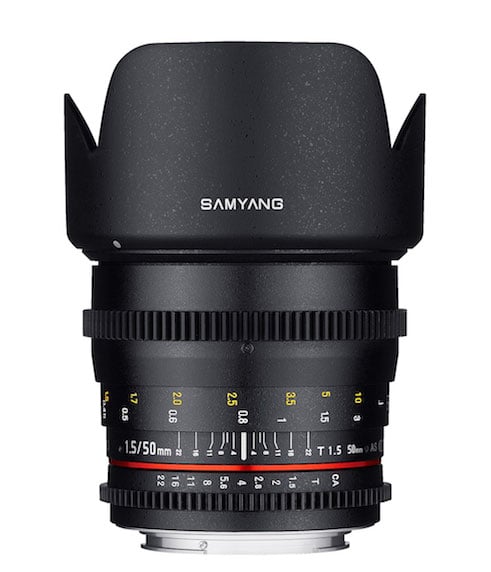
Korean lens giant Samyang has finally introduced a prime to fill the gap between its well-regarded 35mm and 85mm offerings.
The cine version of the new lens will be introduced alongside the photographic version at Photokina next month. The company has a set of lenses oriented toward the motion-picture market which has been important for a while. Not important in the same way as Cooke is important to people shooting commercials for luxury chocolates, or in the same way as the cleanliness and precision of Zeiss is to a hard sci-fi movie, but nonetheless critical in a situation where demand for lenses has never been greater and not everyone has six figures to spend on glass.
The high-end is lovely and, from what we've seen recently, in absolutely no danger whatsoever of running out of customers, but the need for affordable lenses to support affordable cameras has never been clearer.
Until now, however, there's been a conspicuously missing option in the V-DSLR series, which is clearly based on the company’s range of stills lenses. The assumption that a 50mm lens is some sort of touchstone of normality is no longer entirely reliable, given the profusion of sensor sizes available, but the gap between 35mm and 85mm was always a bit too big to really call it a range so much as a clearly rather incomplete selection.
Hence the new release.

Other 50mm primes are of course available, if you can find one that matches at least as well as the rest of the range, but offering a range of movie primes without a 50 was always going to attract comment. The company has sensibly included field-of-view numbers for various sensors in the released materials, which hover around the 30-degree mark for common DSLR dimensions.
Price-performance ratio is generally high at this end of the market, which is not to say that the lens is likely to compete with the Zeiss ZE series, at a few times the money, but reviews have been favourable to date and we can reasonably expect entirely decent performance. The T1.5 aperture is nice from the point of view of that warm, comforting feeling we get when stopping down for better optical performance, which we can do on this lens without sacrificing too much light – although the company clearly knows how comforting low numbers can be, and performance wide open is naturally an unknown quantity at this point.
Even if you can find a cheaper tangle of glass and metal, and even if it has equivalent optical performance, the expanded focus throw, easily accessible gearing and clickless aperture adjustment are worth taking into account when comparing these primes to perhaps cheaper stills-oriented lens. They don't, unfortunately, have the advantages of the really expensive stuff, where the focus rings tend to all be in the same position and the physical dimensions and weight identical across the range. For the money, though, that's an entirely reasonable engineering compromise, especially given the fact that the range is available in no less than ten mounts.
Presumably, in order to be meaningful, the cost will be a few hundred US dollars, in the same sort of region as the rest of the range.
SAMYANG 50mm with Blackmagic Cinema Camera - Krakow